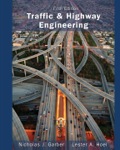
Concept explainers
A suitable thickness of the concrete pavement if the working stress of the concrete is
Answer to Problem 20P
The suitable depth of concrete pavement is
Explanation of Solution
Given:
Design life is
Annual rate of traffic growth is
Sub grade
Stabilized sub-base is of
Modulus of rupture of the concrete is
Traffic volume data on the highway indicate that the AADT during the first year of operation is
The pavement has aggregate interlock joints (no dowels) and a concrete shoulder.
Formula used:
The design equivalent single axle load is given by,
Here,
The total ESAL is given by,
Here,
The stress ratio is given by,
Here,
The damage percent is given by,
Here,
Calculation:
The design equivalent single axle load for
Substitute
The design equivalent single axle load for
Substitute
The design headwater depth is calculated as,
Substitute
The sub grade value of
From table 20.22, "Deign
Assume a slab
From table 20.24, "Equivalent stress values for single axles and tandem axles" of book "Traffic and highway engineering" equivalent stress values can be obtained and for
The stress ratio is calculated as,
Substitute
From table 20.27, "Erosion factors for single axles and tandem axles (doweled joint, concrete shoulder" of book "Traffic and highway engineering" for
From figure 20.26, "Allowable Load Repetitions for Fatigue Analysis Based on Stress Ratio" of book "Traffic and highway engineering" for
Thus, the Fatigue analysis for
From figure 20.27, "Allowable Load Repetitions for Erosion Analysis Based on erosion factors" of book "Traffic and highway engineering" for
From figure 20.26, "Allowable Load Repetitions for Fatigue Analysis Based on Stress Ratio" of book "Traffic and highway engineering" for
From figure 20.27, "Allowable Load Repetitions for Erosion Analysis Based on erosion factors" of book "Traffic and highway engineering" for
The table showing the allowable repetitions for
| Load | Fatigue analysis | Erosion analysis |
| | Unlimited | Unlimited |
| | | |
Table (1)
So the
Assume a slab
Calculate the equivalent stress.
From table 20.24, "Equivalent stress values for single axles and tandem axles" of book "Traffic and highway engineering" equivalent stress values can be obtained and for
The stress ratio is calculated as,
Substitute
From table 20.27, "Erosion factors for single axles and tandem axles (doweled joint, concrete shoulder" of book "Traffic and highway engineering" for
From figure 20.26, "Allowable Load Repetitions for Fatigue Analysis Based on Stress Ratio" of book "Traffic and highway engineering" for
Thus, the Fatigue analysis for
From figure 20.27, "Allowable Load Repetitions for Erosion Analysis Based on erosion factors" of book "Traffic and highway engineering" for
From figure 20.26, "Allowable Load Repetitions for Fatigue Analysis Based on Stress Ratio" of book "Traffic and highway engineering" for
From figure 20.27, "Allowable Load Repetitions for Erosion Analysis Based on erosion factors" of book "Traffic and highway engineering" for
The table showing the allowable repetitions for
| Load | Fatigue analysis | Erosion analysis |
| | Unlimited | Unlimited |
| | unlimited | |
Therefore, the
Conclusion:
Therefore, the suitable depth of concrete pavement is
Want to see more full solutions like this?
Chapter 20 Solutions
Traffic and Highway Engineering
- Repeat Problem 19-7 using two different depths of untreated aggregate bases of 6 in. and 12 in. Highway contractors in your area can furnish rates for providing and properly laying an asphalt concrete surface and untreated granular base. Assume a structural coefficient of 0.12 for the base course. If these rates are available, determine the cost for constructing the different pavement designs if the highway section is 5 miles long and the lane width is 12 ft. Which design will you select for construction?arrow_forwardQ#3. Discuss root causes and remedial measures of the following distresses occurring in flexible pavements: Slippage failure, Potholes, Rutting and its types, Bitumen bleedingarrow_forwardquestion 2 please, Pavementarrow_forward
- Define precisely the difference between pavement serviceability and performance. Using a sketch to indicate the concept of remaining service life of a pavement segment.arrow_forwardPlease answer clearly Explain root causes and remedial measures of the following distresses occurring in flexible pavements: Slippage failure, Potholes, Rutting and its types, Bitumen bleeding ?arrow_forwardDiscuss the strategy of pavement evaluation process in detailarrow_forward
- A flexible pavement has a structural number of 3.8(all drainage coefficients are equal to 1.0). The initialPSI is 4.7 and the terminal serviceability is 2.5. The soilhas a CBR of 9. The overall standard deviation is 0.40and the reliability is 95%. The pavement is currentlydesigned for 1800 equivalent 18-kip single-axle loadsper day. If the number of 18-kip single-axle loads wereto increase by 30%, by how many years would thepavement’s design life be reduced?arrow_forwardReplace the 5 forces acting on the next pavement with a single force and position it so as to obtain a equivalent system.arrow_forwardDescribe the pavement design. Discuss are the main features of rigid and flexible pavement.arrow_forward
- A rigid pavement on a new interstate (3 lanes each direction) has been conservatively designed with a 12- inch slab, an Ec of 5.5 x 106 lb/in2 , a concrete modulus of rupture of 700 lb/in2 , a load transfer coefficient of 3.0, an initial present serviceability index of 4.5, and a terminal serviceability index of 2.5. The overall standard deviation is 0.35, the subgrade CBR is 25, and the drainage coefficient is 0.9. The pavement was designed for 600 30-kip tandem axles per day and 1400 20-kip single axle loads per day. If the desired reliability was 90%, how long was this pavement designed to last?arrow_forwardPls answer w/ complete solution. Asap (Transportation Engineering) Determine the thickness base and subgrade of flexible pavement if the wheel load is 90 kN and has wheel contact area of 88075 sq. mm.. Strength capacity of base is 0.35 MPa and 0.15 MPa for Subgrade.arrow_forwardWhat will be the proper pavement to use when the traffic loads consist of heavy trucks or wheeler trucks?arrow_forward
 Traffic and Highway EngineeringCivil EngineeringISBN:9781305156241Author:Garber, Nicholas J.Publisher:Cengage Learning
Traffic and Highway EngineeringCivil EngineeringISBN:9781305156241Author:Garber, Nicholas J.Publisher:Cengage Learning
